This case study, conducted by Isaac Phillips, Innovation Specialist at Starr Electric, demonstrates the power and efficiency of Drawer AI when working with the large-scale 300,000 sq ft Cancer Center project. The Drawer AI platform revolutionizes the process of working with electrical drawings, transforming hours of manual work into minutes of automated analysis.
Drawer AI Case Study: Cancer Center CD Set
🕑 February 6, 2025
Executive Summary
Key Performance Metrics
Volume Processed
3,361
Receptacle Symbols
3,284
Fixture Symbols
Traditional vs. AI Comparison
Power Devices
Lighting Devices
Key Benefits
Time Savings
Days → Hours/Minutes
Exceptional Accuracy
Comprehensive Classification
Issue Detection
Before Construction
Intuitive QA Tools
Rapid Verification
Process and Results
1. Setup, Upload and Indexing
The speed that impresses!
The initial upload took only a couple of minutes. While separating and indexing the pages required some time, once the drawings appeared, they became immediately available for viewing and working.
Incredible recognition accuracy:
The system automatically identified and extracted data from the panel and lighting fixture schedules. The panel schedule data extracted was used to drive the wire sizing process. The lighting fixture schedule data extracted informed the lighting fixture detection process.

Benefit:
Drawer AI automated separated PDFs into drawings, named the drawings by extracting title block information, and extracted schedule data. The process was fast and easy, saving manual prep time and preparing the project for accurate symbol detection and wire sizing!
2. Stitching
Drawer AI allows you to combine separate drawings into comprehensive plans, greatly simplifying subsequent work. Stitching was performed on lighting and power plans per floor and typically took anywhere from 2.5 to 7 minutes depending on the concentration of elements.
Example:
A 7-page stitch of the Level 2 lighting plan was performed flawlessly, creating a comprehensive drawing of the entire floor for further analysis.
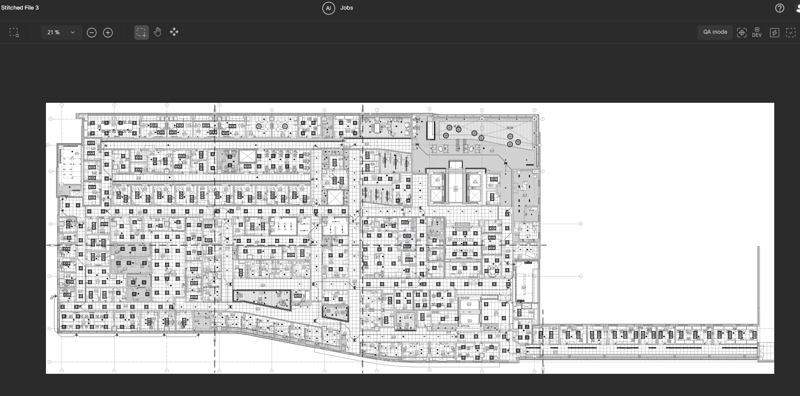
Benefit:
Forget about manual drawing stitching or having to coordinate across multiple plans for the same floor! Drawer AI automatically creates a complete picture of the floor, allowing you to see the full perspective.
3. Lighting Fixture Detection and Adjustments
Two approaches were taken for this project regarding light fixture detection, and both worked exceptionally well:
Approach 1: Step-by-Step Detection
- Detection was performed individually on three 7-page stitches (ground level, level 1, and level 2)
- Number of detected items: from 425 to 726
- Detection time: from 6 to 15 minutes per stitched drawing
Approach 2: Group Detection
- Staying on the project's main page, three remaining stitched plans were selected and the lighting takeoff action was run from there
- Total number of detected items: 845
- Process time: just over 7 minutes
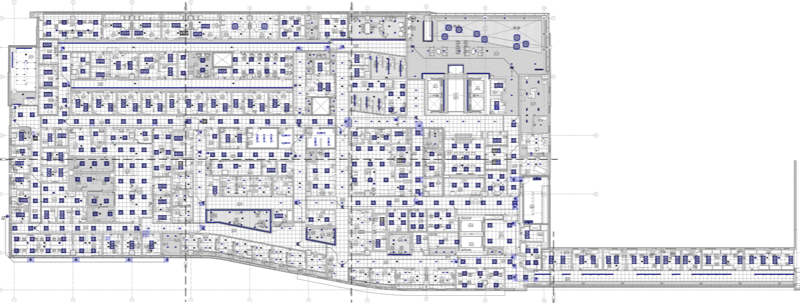
Quality Assurance (QA)
Several strategies were employed to ensure accuracy:
• Selective Verification: Items were selected directly on the floor plan, highlighting fixtures by type for QA classification.


Benefit:
Drawer AI transforms days of painstaking manual identification into minutes of automated processing while maintaining exceptional accuracy. With its intuitive QA tools, verification becomes quick and highly reliable, ensuring every element is correctly classified and accounted for.
4. Power Device Detection and Adjustments
Impressive detection speed:
- Detection was done on an individual stitched drawing basis
- Number of items detected: from as low as 62 (shell space floors) to 982
- Duration of detection: from 57 seconds to 7 minutes depending on the number of elements
- It's noteworthy that a 6-page stitch with 982 items took just 5.5 minutes!
Adapted QA process:
- Given the nature of the symbols and their varying features, a specialized approach to QA was applied
- The Pop-Out feature in the Takeoff Pad helped separate it into its own window on another screen
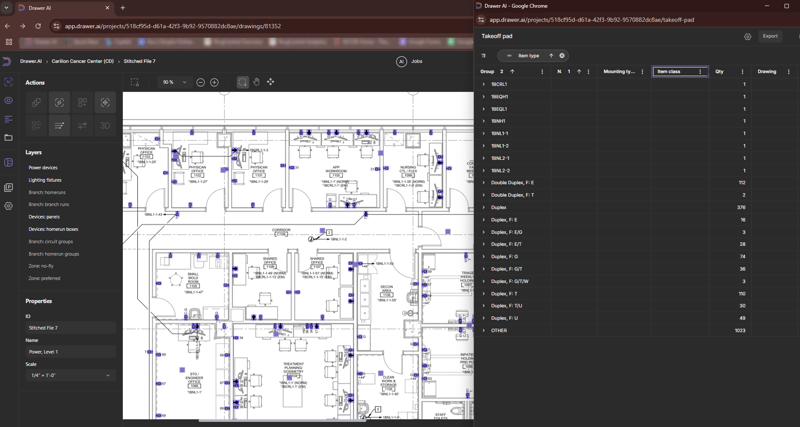
- Using the Select Tool to review devices by selected areas
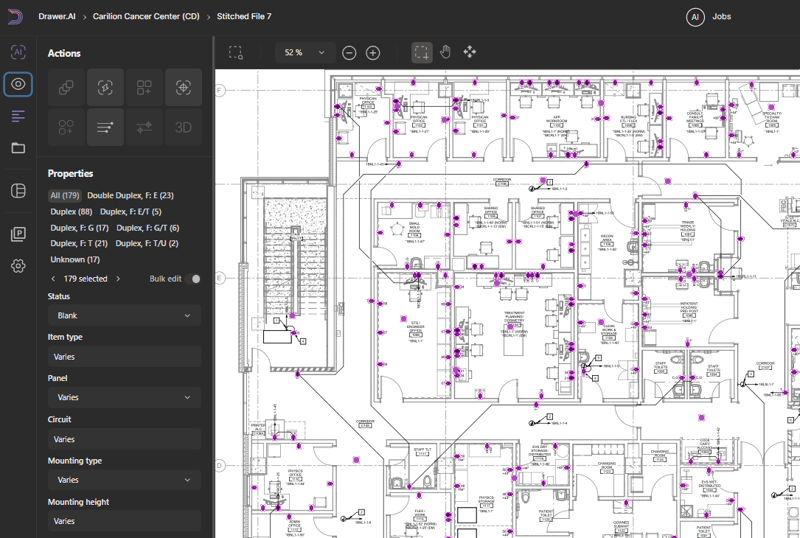
- Display all individual item types in the Bulk Edit area for easier review
Benefit:
Drawer AI easily handles even the most complex plans, detecting hundreds of elements in minutes – this is a revolution in the takeoff process!
5. Circuit Tags and Branch Routing
Project specifics:
- Utilization of circuits/panels-by-area without traditional connected circuit lines
- Some rooms had a devices assigned to the same panel and circuit to serve the entire room
- Some rooms had devices assigned to two different panels and circuits (normal and emergency)
- Emergency devices have a distinct symbol difference from their normal counterparts
- Some rooms simply had a panel name, with individual devices having a circuit number next to them
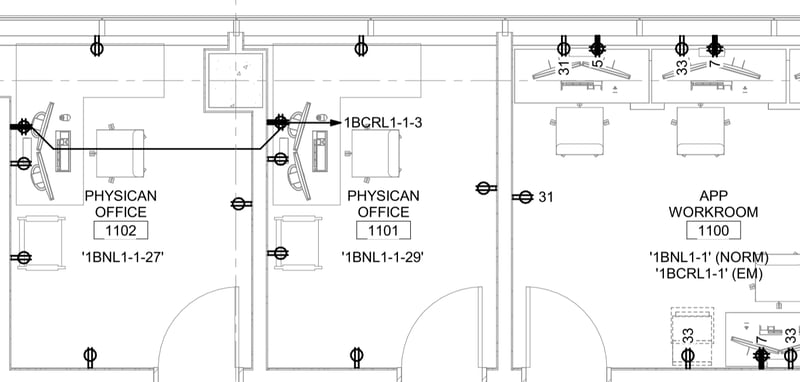
Work process:
- Using multi-select and Bulk Edit features to grab many devices on a common circuit
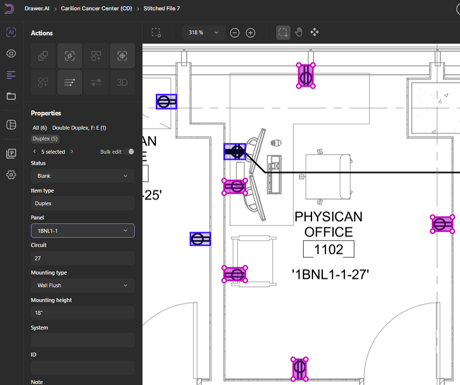
- Setting up Preferred Zones and No-Fly Zones for branch routing
- Setting initial parameters (70% Preferred Zone Reward and 25ft grouping distance)
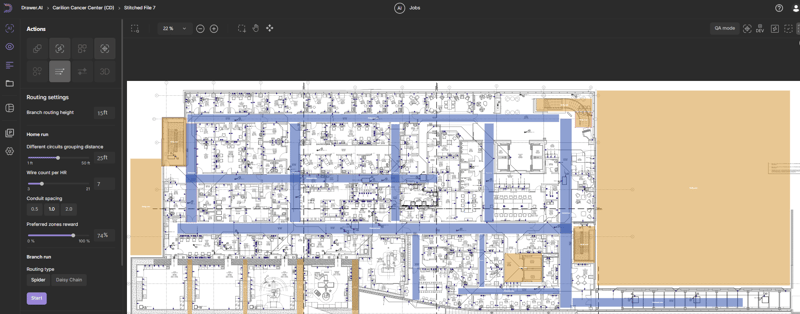
- Branch routing took anywhere from 30 seconds to just under 2 minutes
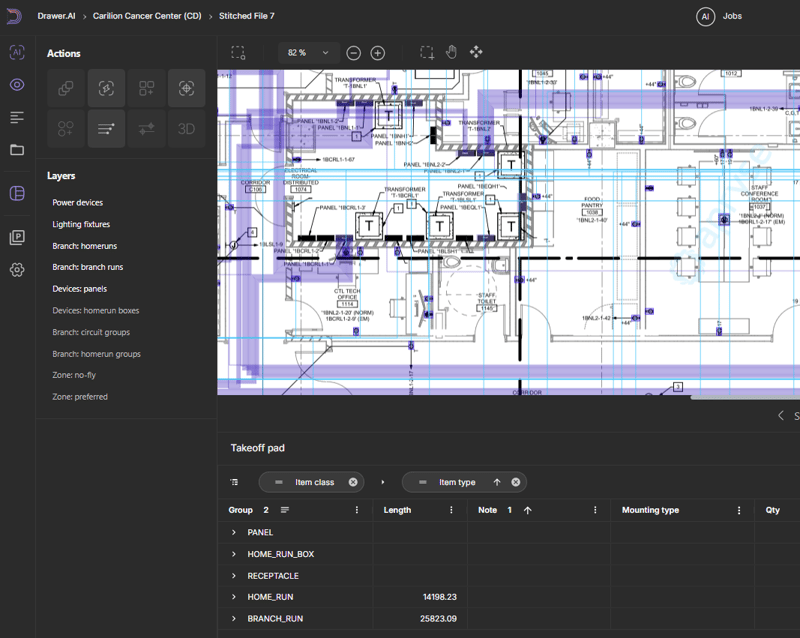
Project peculiarities discovered:
- When analyzing conduit footages, extremely large total lengths were detected
- The circuit group diagrams helped identify the cause of large conduit volumes
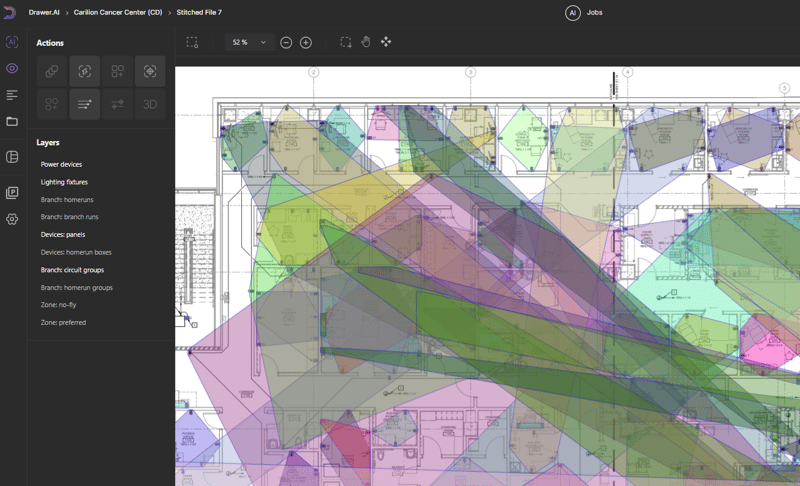
- The project contained numerous large, stretched-out polygons, some spanning nearly the entire length of the building
- Analysis revealed discrepancies between circuits listed in the panel schedule and those on the floor plan
Benefit:
Drawer AI doesn't just identify elements – it reveals potential project issues before construction begins, saving tens of thousands of dollars in possible errors!
Summary
The implementation of Drawer AI for the Cancer Center project demonstrated the impressive efficiency and accuracy of the platform when working with large-scale projects. The key benefits demonstrated were:
- Significant time savings: Processes that typically take days were completed in hours, and in some cases – minutes.
- Exceptional accuracy: The system not only detected thousands of elements but correctly classified them and provided an easy way to verify the results.
- Project issue detection: Drawer AI helped identify inconsistencies in project documents that could have led to serious problems during construction.
- Approach flexibility: The platform demonstrated the ability to work effectively with different analysis strategies, adapting to the specifics of the project.
- Intuitive QA tools: Various quality verification methods made the result verification process quick and reliable.
Drawer AI proves that artificial intelligence technologies can not only automate routine tasks but also improve design quality, identify potential problems, and significantly reduce the time from design to construction. It's not just a tool – it's a new approach to working with electrical projects that puts efficiency, accuracy, and quality first.
Fixture Symbols
| Floor | Total | Detection | QA | Total Time | Traditional Time | Savings |
|---|---|---|---|---|---|---|
| G | 416 | 0:05:45 | 0:07:00 | 0:12:45 | 0:30:00 | 57.5% |
| 1 | 767 | 0:15:22 | 0:12:00 | 0:27:22 | 2:30:00 | 81.7% |
| 2 | 681 | 0:13:53 | 0:16:00 | 0:29:53 | 2:30:00 | 80.1% |
| 3 | 387 | 0:07:19 | 0:10:25 | 0:17:44 | 1:30:00 | 80.3% |
| 4 | 185 | 0:02:00 | 0:02:00 | 0:30:00 | 93.3% | |
| 5 | 621 | 0:18:20 | 0:07:52 | 0:26:12 | 2:30:00 | 82.5% |
| 6 | 172 | 0:01:27 | 0:02:36 | 0:04:03 | 0:30:00 | 86.5% |
| 7 | 55 | 0:00:48 | 0:03:16 | 0:04:04 | 0:25:00 | 83.7% |
| Total | 3284 | 1:02:54 | 1:01:09 | 2:04:03 | 10:55:00 | 81.1% |
Receptacle Symbols
| Floor | Total | Detection | Feature QA | Total Time | Traditional Time | Savings |
|---|---|---|---|---|---|---|
| G | 205 | 0:02:45 | 0:06:09 | 0:08:54 | 0:45:00 | 80.2% |
| 1 | 839 | 0:04:24 | 0:40:00 | 0:44:24 | 2:45:00 | 73.1% |
| 2 | 857 | 0:07:00 | 0:43:00 | 0:50:00 | 2:45:00 | 69.7% |
| 3 | 358 | 0:02:45 | 0:24:54 | 0:27:39 | 1:15:00 | 63.1% |
| 4 | 57 | 0:00:57 | 0:04:12 | 0:05:09 | 0:30:00 | 82.8% |
| 5 | 948 | 0:05:29 | 0:55:09 | 1:00:38 | 3:00:00 | 66.4% |
| 6 | 51 | 0:01:56 | 0:03:26 | 0:05:22 | 0:30:00 | 82.1% |
| 7 | 46 | 0:00:57 | 0:02:00 | 0:02:57 | 0:30:00 | 90.2% |
| Total | 3361 | 0:26:13 | 2:58:50 | 3:25:03 | 12:00:00 | 71.5% |
Summary of Time Savings
- Receptacle Symbols: 71.5% time savings (3:25:03 vs traditional 12:00:00)
- Fixture Symbols: 81.1% time savings (2:04:03 vs traditional 10:55:00)
- Total Combined: 76.1% time savings (5:29:06 vs traditional 22:55:00)
Note: The traditional estimator stated that counts for a non-densely populated floor plan would take 5-10 minutes and for more densely populated plans, 25-30 minutes (with power devices requiring more time).
Ready to Take Your Workflow to the Next Level?
You’ve seen how Drawer AI can streamline your takeoff process and save you time. Now, it’s time to put it to work for you!